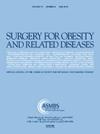密歇根减肥手术合作结果计算器在西班牙裔人群中的验证。
IF 3.8
3区 医学
Q1 SURGERY
引用次数: 0
摘要
背景:密歇根减肥外科合作组织(MBSC)开发了一款计算结果的应用程序,包括预测体重减轻和静脉血栓栓塞率。这款应用程序名为“衡量胜算”。这个应用程序提供了一个与患者讨论结果的重要方法。目的:我们试图确定MBSC结果计算器在西班牙裔人群中的有效性。背景:德克萨斯州的社区实践。方法:一个有大量西班牙裔患者的社区实践被用来验证MBSC计算器。计算相关系数。采用卡方检验比较手术类型间的定量变量。使用Lin的一致性相关和Bland-Altman图来估计1年实际和预期权重之间的一致程度。结果:276例患者符合入选标准,纳入研究。初始减肥手术时的平均体重指数(BMI)为45.2 kg/m2(标准差[SD], 6.68)。177例患者接受了袖胃切除术(SG), 99例患者接受了Roux-en-Y胃旁路术(RYGB)作为他们最初的减肥手术。整个队列1年的平均实际体重为90.8 kg (SD, 19.6),而平均预期体重为89.2 kg (SD, 16.9),导致平均差异为1.6 kg。一致性相关系数为0.80 (95% CI: 0.76 -。84, P < .001)表明1年的实际和预期权重之间有很强的一致性。RYGB患者的相关系数较低。结论:1年的实际体重与预期体重具有较强的一致性。这些发现在西班牙裔人群中验证了MBSC结果计算器。本文章由计算机程序翻译,如有差异,请以英文原文为准。

Validation of the Michigan Bariatric Surgery Collaborative outcomes calculator in a Hispanic population
Background
The Michigan Bariatric Surgery Collaborative (MBSC) has developed an app that calculates outcomes, to include predicted weight loss and venous thromboembolism rates. The app is called Weigh the Odds. This app provides an important method for discussing outcomes with patients.
Objectives
We sought to determine the validity of the MBSC outcomes calculator in a Hispanic population.
Setting
Community practice in Texas.
Methods
A community practice with a large percentage of Hispanic patients was used to validate the MBSC calculator. The correlation coefficient was calculated. A chi-square test was used to compare quantitative variables between the operation types. Lin’s concordance correlation along with the Bland-Altman plot were performed to estimate the level of agreement between actual and expected weights at 1 year.
Results
Two hundred seventy-six patients met the eligibility criteria and were included in the study. The average body mass index (BMI) at the time of initial bariatric surgery was 45.2 kg/m2 (standard deviation [SD], 6.68). One hundred seventy-seven patients underwent sleeve gastrectomy (SG), and 99 patients underwent Roux-en-Y gastric bypass (RYGB) as their initial bariatric operation. The mean actual weight at 1 year for the entire cohort was 90.8 kg (SD, 19.6), while the mean expected weight was 89.2 kg (SD, 16.9), leading to a mean difference of 1.6 kg. The concordance correlation coefficient of .80 (95% CI: .76-.84, P < .001) demonstrates a strong agreement between actual and expected weights at 1 year. There was a lower correlation coefficient for RYGB patients.
Conclusion
The concordance correlation coefficient demonstrated a strong agreement between actual and expected weights at 1 year. These findings validate the MBSC outcomes calculator in a Hispanic population.
求助全文
通过发布文献求助,成功后即可免费获取论文全文。
去求助
来源期刊
CiteScore
6.70
自引率
12.90%
发文量
570
审稿时长
56 days
期刊介绍:
Surgery for Obesity and Related Diseases (SOARD), The Official Journal of the American Society for Metabolic and Bariatric Surgery (ASMBS) and the Brazilian Society for Bariatric Surgery, is an international journal devoted to the publication of peer-reviewed manuscripts of the highest quality with objective data regarding techniques for the treatment of severe obesity. Articles document the effects of surgically induced weight loss on obesity physiological, psychiatric and social co-morbidities.

 求助内容:
求助内容: 应助结果提醒方式:
应助结果提醒方式:


